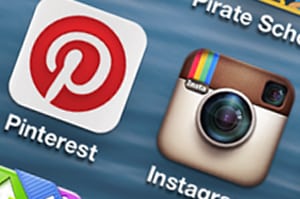 What could be better for a brand than consumers buzzing about how badly they want their products — and bragging about how awesome it is as soon as they have it in their hands?
What could be better for a brand than consumers buzzing about how badly they want their products — and bragging about how awesome it is as soon as they have it in their hands?
Luckily for merchants, Pinterest and Instagram pack that one-two product punch: Users pin the items they covet and proudly ‘gram their purchases. And while these two image-based social platforms seem so similar on the surface — they’re pretty, they’re delightful distractions, and they connect you with both friends and brands — potential customers browse pins for completely separate reasons than they scroll through their Instagram feed.
No two merchant think the same about Pinterest and Instagram. Here are some of the opportunities each visual platform offers and strategies for optimizing your outreach.
Pinterest = Pre-Purchase Aspiration
Pinterest is about discovery. It’s a seemingly endless wealth of inspiring ideas, how-tos, and products. So, how can brands reach out to these Pinterest dreamers and transform that into sales?
1. Create a seamless transition between Pinterest and ecommerce. Brands like Everlane are already encouraging product pins with Pin-It buttons placed directly over their items, a noticeable reminder to add to a must-have board. Retailers like REI and Anthropologie have taken this a step further, partnering with Pinterest in May 2013 to launch RichPins – enabling Pinterest users to see pricing and availability information without having to leave Pinterest.
Take it a step further: Consider finding where users are pinning your products and commenting with a coupon code to give them a little extra incentive to make a purchase.
2. Fit products into their dream lifestyles. Instead of simply pinning product images, demonstrate how they can be used. ModCloth again does an excellent job of rethinking their clothes as pinnable pictures, including user generated images that click through to a “Shop the Look” page and employee style spotlights that lead to a blog on what she’s wearing.
Take it a step further: Up the covet factor with a sneak-peek board which gives an exclusive look at new products, including ultra-pinnable lifestyle images of how the items can be used.
UGC PIN: http://pinterest.com/pin/75716837457739185/
EMPLOYEE SPOTLIGHT PIN: http://blog.modcloth.com/2013/04/24/employee-outfit-heat-wave/
3. Invite consumers to crave with you. Whether you encourage users to pin along with a hashtag or select a group of online influencers to curate a shared pinboard, crowdsourcing will up your content on Pinterest and increase followers — which will get more eyes on the products you pin. Whole Foods Market currently has over 134,000 followers drooling over their recipe boards, which are comprised of dishes from Whole Foods’ site and pins from other users. In the end, which grocery store will consumers flock to so that they can whip up the mango salad they’re now craving?
Take it a step further: Bolster this new community with an opt-in email list serve dedicated to Pinterest, which keeps the pins coming with updates on new boards, trends, and products.
Instagram = Post-Purchase Celebration
Consider Instagram as a visual depiction of your life, glossed over with instant-image-improving filters and neatly cropped into squares. So suffice it to say a little bragging comes with the territory. Here’s how to get users boasting about what they buy from your brand:
1. Reward customers for modeling your products. Want to make sure your brand gets a shout-out? Just give your users 15 minutes of Instagram fame. Brands like Bauble Bar frequently post user generated photos of happy customers wearing their jewelry (complete with styling tips). This spotlight not only persuades users to mention your brand in their posts, it also amplifies customer satisfaction.
Bauble Bar customer spotlight: http://instagram.com/p/bCaAS9L_9Z/
Bauble Bar customer styling tip: http://instagram.com/p/bC4vqvL_7y/
Take it a step further: Grab customers’ attention with user-generated Instagram features in email receipts or in-store send-off cards so that consumers are inspired to ‘gram their new purchases.
2. Start a conversation. Smirnoff took two approaches to get more eyes on their Instagram page (and products) — launch a fun contest, then convince influencers in the space to generate buzz around it. How it worked: In the weeks leading up to the holiday, Smirnoff began promoting their Fourth of July #PartyHacks campaign, which asked followers to share their Smirnoff party hacks, complete with hashtag, for a chance to be featured. They also recruited a group of bloggers with thousands of their own Instagram followers to temporarily take over their handle and post their own party hacks. What it achieved: It leveraged influencers thousands of fans to increase awareness (and ideally followers) of Smirnoff’s Instagram page, plus it accounted for a whole lot of product placement (all of the bloggers pictured Smirnoff in their party hacks). Takeaway? Tap into influencers and have a little fun with it, and it will get people talking.
Smirnoff party hack: http://instagram.com/p/bcJBZkOdG-/
Smirnoff influencer promoting contest: http://instagram.com/p/bY3sU1w5ho/
Take it a step further: When you know your brand is involved in an event, search relevant hashtags to find conversations that are already happening.
3. Make it about your fans. Think outside the cropped Instagram box with a feature that your user will love that cleverly shows off your brand. Nike really got creative with their PHOTOid design tool, which allows users to design (and potentially purchase) new Nike kicks based on the colors in their Instagram feeds. This tactic increases the brand’s social cred, not to mention it makes the process of buying something a blast for customers — a lucky bunch can even see their sneaks featured on the site.
Take it a step further: Making purchases more social isn’t just fun, it will increase the likelihood your customer will share their experience. Designate contests that involve your product with a special hashtag and then feature contributions on your site or in a Facebook tab.
Apu Gupta is CEO of social media analytic platform Curalate.
